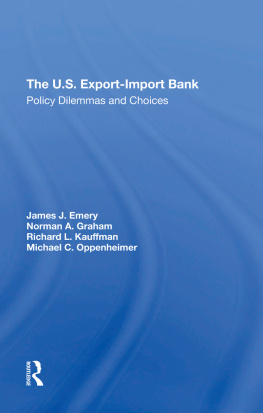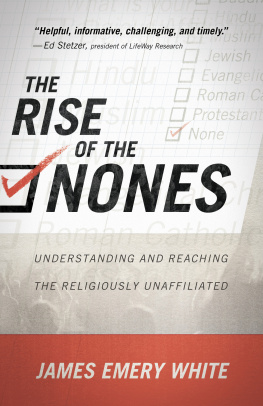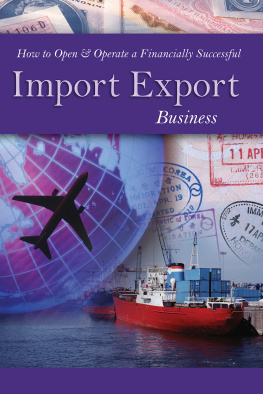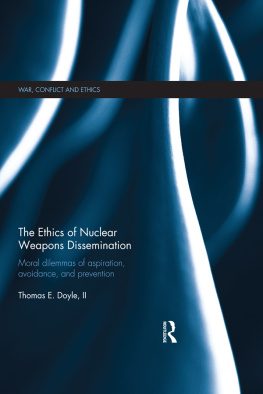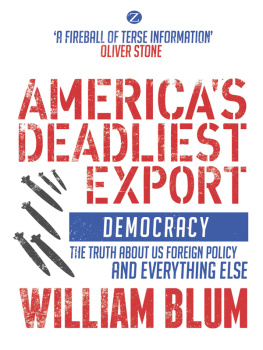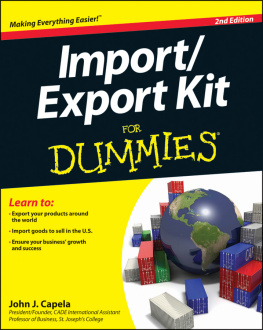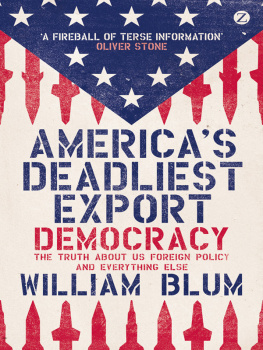The U.S. Export-Import Bank
Westview Replica Editions
The concept of Westview Replica Editions is a response to the continuing crisis in academic and informational publishing. Library budgets for books have been severely curtailed. Ever larger portions of general library budgets are being diverted from the purchase of books and used for data banks, computers, micromedia, and other methods of information retrieval. Interlibrary loan structures further reduce the edition sizes required to satisfy the needs of the scholarly community. Economic pressures on the university presses and the few private scholarly publishing companies have severely limited the capacity of the industry to properly serve the academic and research communities. As a result, many manuscripts dealing with important subjects, often representing the highest level of scholarship, are no longer economically viable publishing projectsor, if accepted for publication, are typically subject to lead times ranging from one to three years.
Westview Replica Editions are our practical solution to the problem. We accept a manuscript in camera-ready form, typed according to our specifications, and move it immediately into the production process. As always, the selection criteria include the importance of the subject, the work's contribution to scholarship, and its insight, originality of thought, and excellence of exposition. The responsibility for editing and proofreading lies with the author or sponsoring institution. We prepare chapter headings and display pages, file for copyright, and obtain Library of Congress Cataloging in Publication Data. A detailed manual contains simple instructions for preparing the final typescript, and our editorial staff is always available to answer questions.
The end result is a book printed on acid-free paper and bound in sturdy library-quality soft covers. We manufacture these books ourselves using equipment that does not require a lengthy make-ready process and that allows us to publish first editions of 300 to 600 copies and to reprint even smaller quantities as needed. Thus, we can produce Replica Editions quickly and can keep even very specialized books in print as long as there is a demand for them.
About the Book and Authors
The U.S. Export-Import Bank: Policy Dilemmas and Choices
James J. Emery
Norman A. Graham
Richard L. Kauffman
Michael C. Oppenheimer
This book assesses the politics and programs of the U.S. Export-Import Bank and their relevance to U.S. trade policy. Focusing on the direct loan program for large credits with maturities of more than five years, the authors evaluate the broad criteria employed by the Bank in its decision-making process and the resulting allocation of Bank resources. They also examine the distribution of Bank loans and subsidies across industries and relate this to key industry characteristics such as comparative advantage and export dependence.
The problems faced by the Eximbank in recent yearshigh borrowing costs, intensified export credit competition, limited resources, increased risks, conflicting mandates to be competitive yet self-sustaining -have given tremendous importance to the careful articulation of policy and administration of programs. The authors find Bank policies to be broadly supportive of the U.S. trade policy goals, but also identify several areas of inconsistency and lack of definition and offer alternative means of specifying criteria to overcome these problems.
James J. Emery is a staff economist with The Futures Group, a research and consulting firm, where he is responsible for research and analysis on issues in international trade and finance. Norman A. Graham is currently a senior staff member at The Futures Group, Richard L. Kauffman is a member of the faculty of the Yale School of Organization and Management, and Michael C. Oppenheimer is international vice president of The Futures Group.
The U.S. Export-Import Bank
Policy Dilemmas and Choices
James J. Emery
Norman A. Graham
Richard L. Kauffman
Michael C. Oppenheimer
First published 1984 by Westview Press
Published 2019 by Routledge
52 Vanderbilt Avenue, New York, NY 10017
2 Park Square, Milton Park, Abingdon, Oxon OX14 4RN
Routledge is an imprint of the Taylor & Francis Group, an informa business
Copyright 1984 by Taylor & Francis
All rights reserved. No part of this book may be reprinted or reproduced or utilised in any form or by any electronic, mechanical, or other means, now known or hereafter invented, including photocopying and recording, or in any information storage or retrieval system, without permission in writing from the publishers.
Notice:
Product or corporate names may be trademarks or registered trademarks, and are used only for identification and explanation without intent to infringe.
Library of Congress Catalog Card Number 83-16964
ISBN 13: 978-0-367-29678-0(hbk)
In this volume, we present an analysis of the criteria employed by the Export-Import Bank of the United States (Eximbank; the Bank) in supporting exports, and of the implications of these criteria and the policies they implement for U.S. trade policy. This analysis concentrates only on the direct loan program of the Bank. While the Bank engages in short- and medium-term guarantee and insurance programs, unlike these activities, direct loans involve an actual extension of credit by the U.S. government. As these loans are usually granted on more favorable terms than those available from private, commercial soirees of finance, there is a subsidy involved. The criteria the Bank employs in making decisions to support reauests for financing are important for several reasons. Although the Bank has maintained it does not make a conscious choice among industries, there is a de facto choice being made that is inherent in the decisionmaking criteria the Bank employs. As a result of these factors, the criteria employed by the Bank in its direct loan program are more complex, and perform a much more allocative role than in the short- and medium-term programs.
A number of critics have charged that the Bank concentrates its lending in a few industries and to a handful of firms. This concentration is not the result of direct targeting to these industries, but rather of the criteria the Bank imposes that effectively select these industries. It is essential, in the context of the analysis of decisionmaking at Eximbank, to interpret "criteria" broadly in order to encompass the range of policies and euidelines that are operative. The criteria originate from the various mandates of the Bank's statute, from traditional Eximbank policies, from the current environment in world trade and export finance, and from the pursuit of broader economic policy goals.
Several factors of the international economic environment today have brought official export credits to the fore as an issue in trade policy. The stagnation in economic growth in the industrial countries and steep rises in the cost of imported oil have raised the importance of exports for the United States, as merchandise exports rose from under 5 percent of the gross national product (GNP) in 1970 to 8 percent in 1981. For particular industries, exports have become the mainstay of opportunity for expansion, or even survival. Often these are capital goods industries that have grown to rely on Eximbank financing. With access to many industrial country markets limited by a variety of mechanisms for support of domestic industry, the rapidly growing developing countries have become major export markets. For these countries, financing is often the key to a project's viability. As the United States has lost the broad-based technological lead it previously held over Europe and Japan, competition in these markets has become more sensitive to other factors such as financing. Financing terms have been used more and more as an element of competitiveness, in spite of the Organization for Economic Cooperation and Development (OECD) agreements to set limits on the terms of export credits. Negotiations in the OECD continue and form a constant backdrop to official export credit activity.


